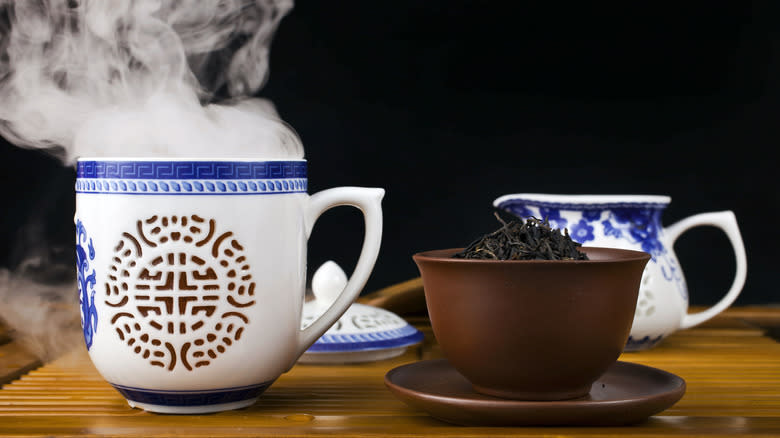The Chinese Cooking Technique That Involves Smoking Foods With Tea Leaves And Sugar

A smoker doesn't have to be a massive grill-adjacent appliance. Cooks in China have been smoking heated tea leaves or wood shavings for centuries, adding flavor, color, and aroma to create fragrant dishes like tea-smoked eggs, camphorwood-smoked duck, smoked fish, and smoked braised pork -- and it can all be done indoors. This Chinese cooking method can refer to raw smoking (which is performed hot, with the dish cooked during the smoking, like smoked duck) or mature smoking (which takes place at a lower temperature and is more of a flavorful finishing touch on already-cooked foods, like tea-smoked eggs).
Per the lore, ancient foodies in Northern China used smoking as a preservation method, extending shelf life by killing bacteria and eliminating moisture from meat and other ingredients. An innovative solution like this was crucial for enduring the region's infamously harsh winters (Northeastern China saw a record-low temperature of -13 degrees Fahrenheit last year).
Proto-smoking was performed by hanging large cuts of cured meat in ancient kitchens and burning wood on the stove nearby -- a passive method that might have been discovered by a happy accident. Older wood-burning stoves were equipped with exhaust pipes, and the meats would be strategically positioned in front of the exhausts to catch all that flavorful wood or tea smoke as it wafted out of the appliance. It wasn't until the Qing Dynasty (which began in the late 1600s) that Chinese home cooks began utilizing smoking for more than just its preservation benefits.
Read more: Hacks That Will Make Boiling Your Eggs So Much Easier
Smoking Can Be A Wok In The Park

Thanks to the wok's thin metal structure and enclosed space, it's the choice of many modern cooks for smoking. Woks can quickly heat foods to their smoke point and allow cooks to manipulate the amount of smoke trapped inside. To do it, the bottom of the wok is lined with aluminum foil, filled with tea leaves and sugar, and heated until smoky. Food is placed on top in a bamboo steamer to soak up all the flavor -- and as such, this cooking technique is all about the choice of burning material used.
For cooks in China, a combination of tea leaves, sugar, and rice is common. Longjing and pu'er teas are popular, and sugar is added for natural one-step caramelization. Intrepid home cooks could play around with different teas like botanical rose or jasmine, spiced-herbaceous lemongrass and ginger, or even savory lapsang souchong, which is already smoked.
A little goes a long way, and it's important not to allow foods to smoke for too long, which can turn them bitter. Tea leaves smoke food more quickly than wood shavings do, but wood imparts a more intense flavor, which is part of the reason why many cooks opt for a combination of both wood and tea in their smokers. Different types of woods from lychee to apple and camphor are all fair game. To customize their flavor profile even further, some cooks add grains, tangerine peels, or spices like cinnamon.
Read the original article on Tasting Table.

